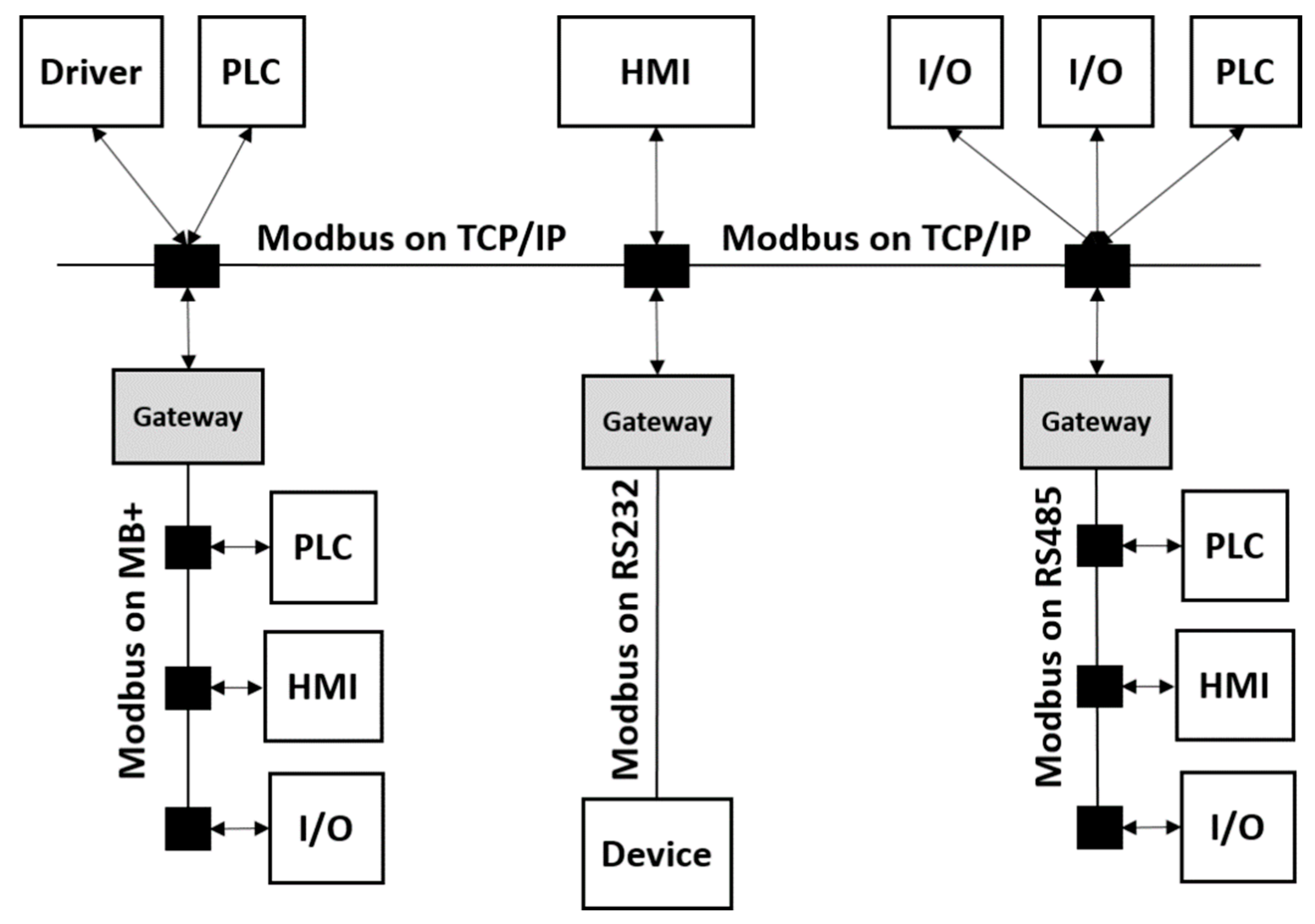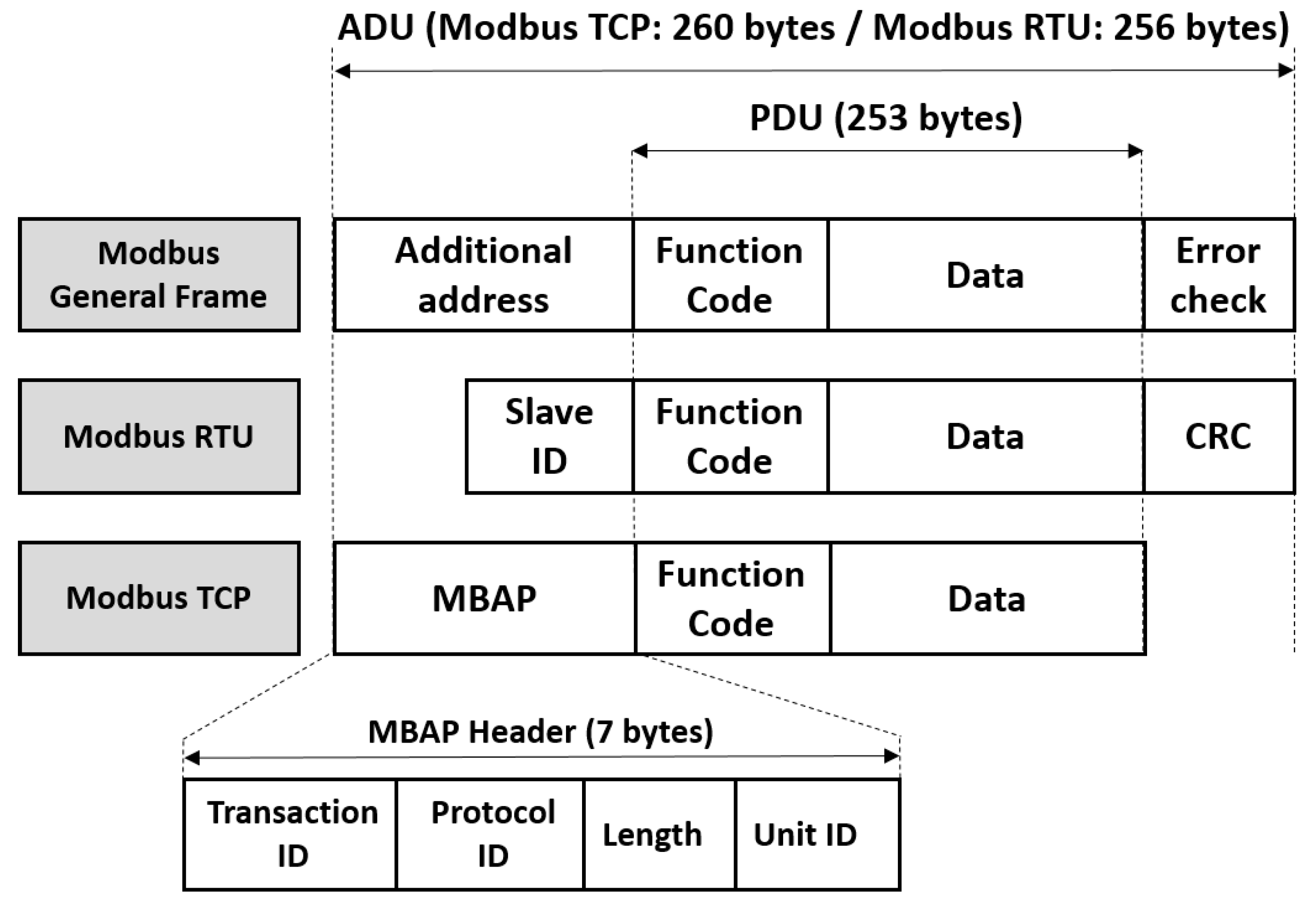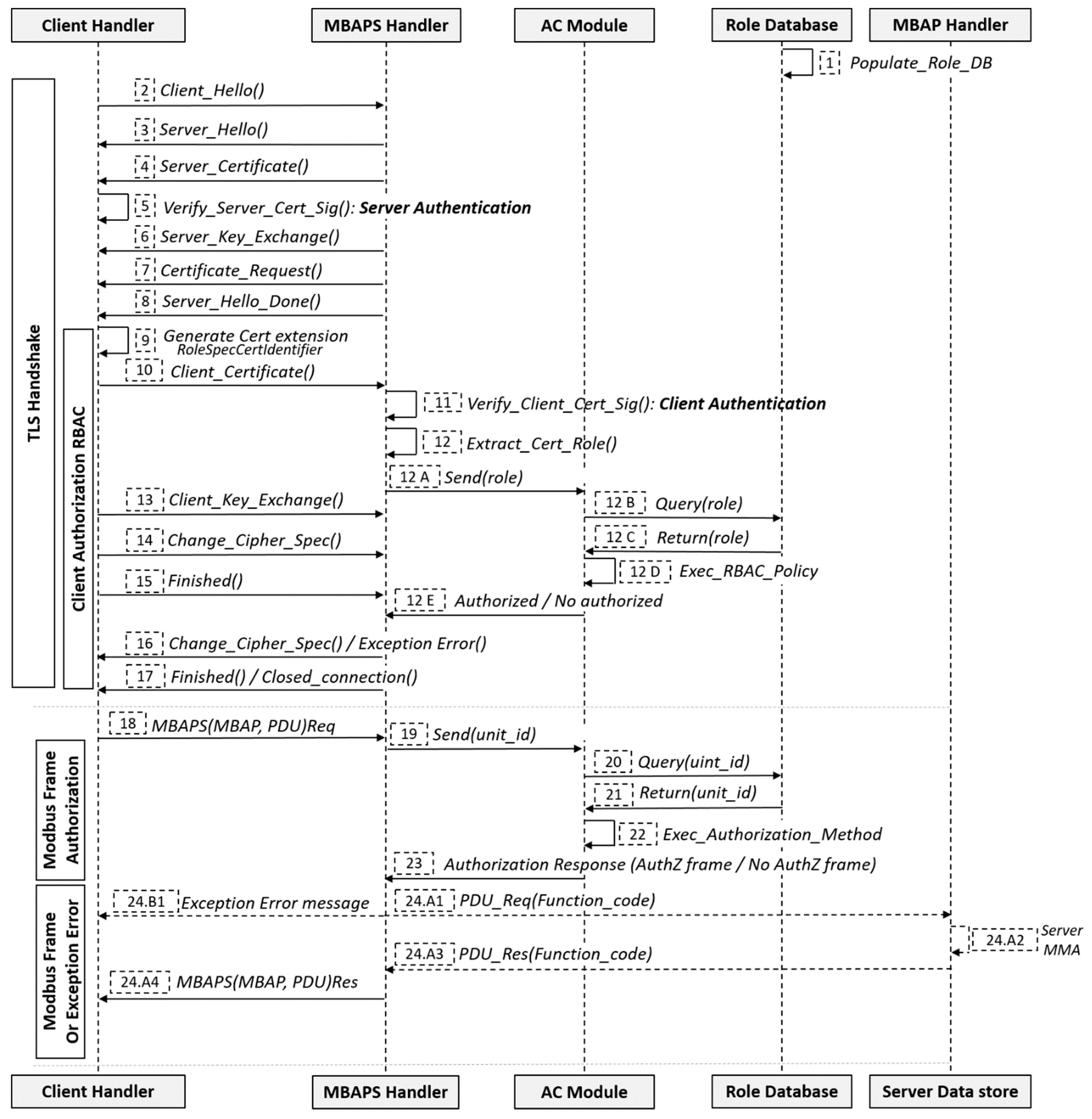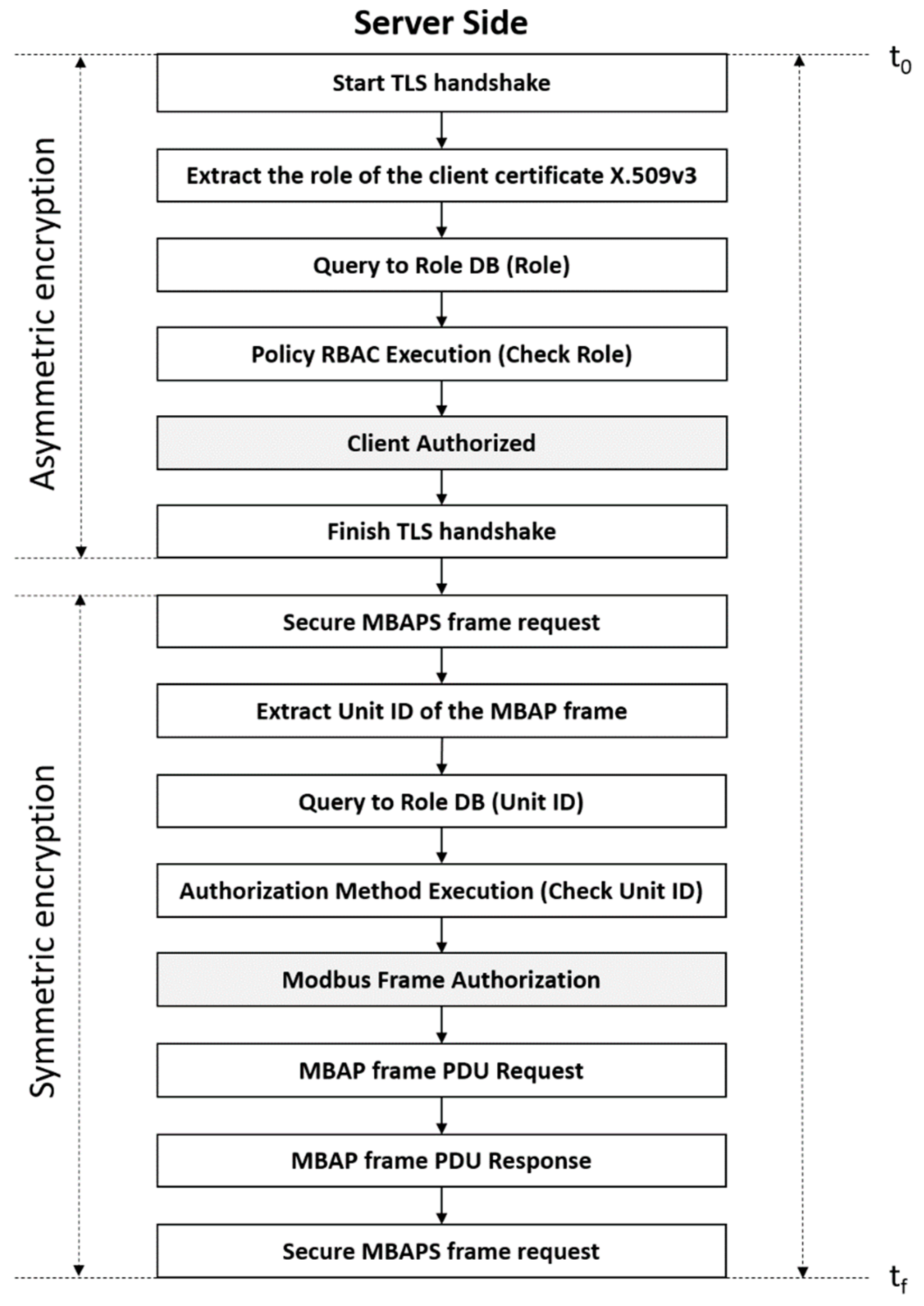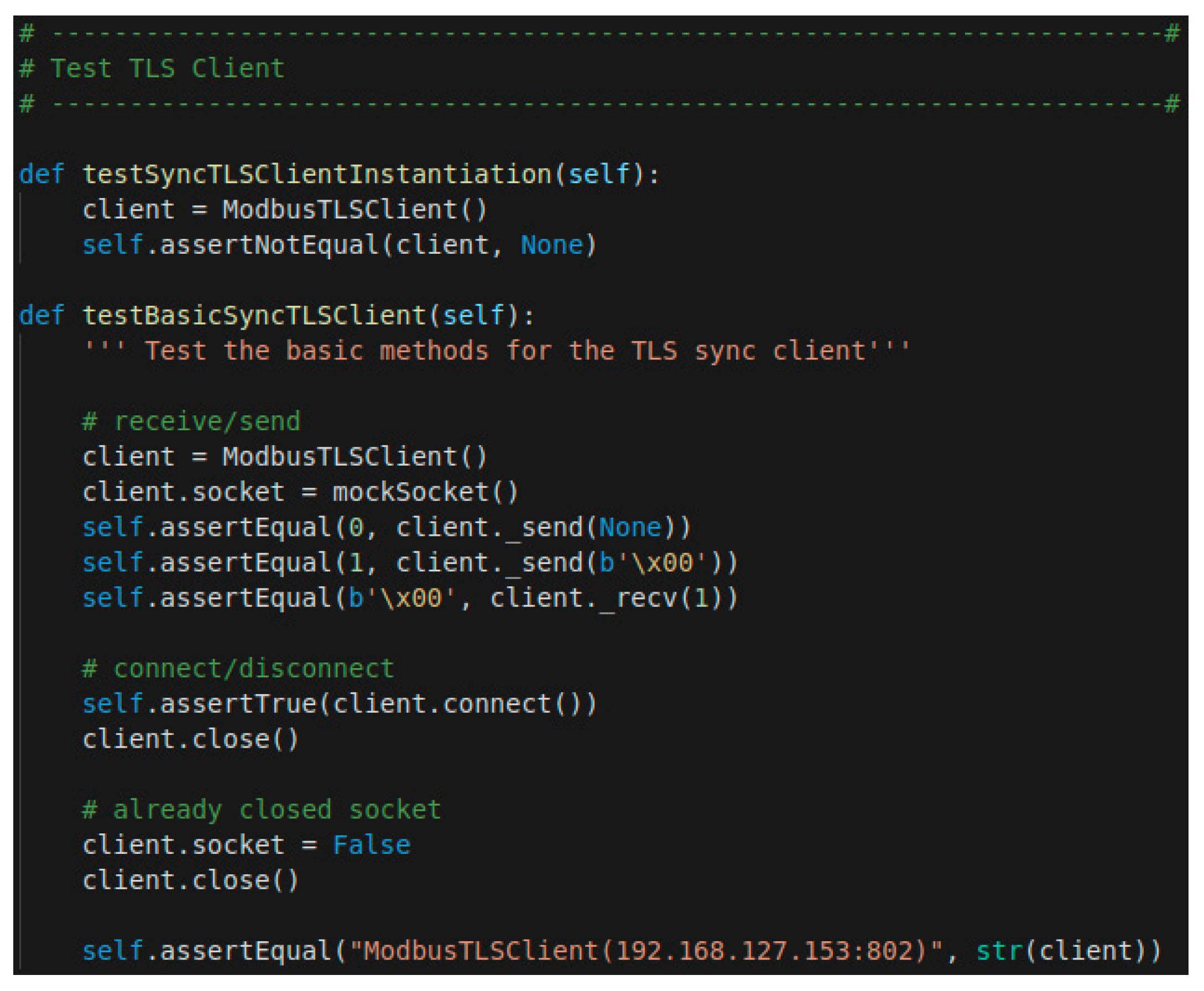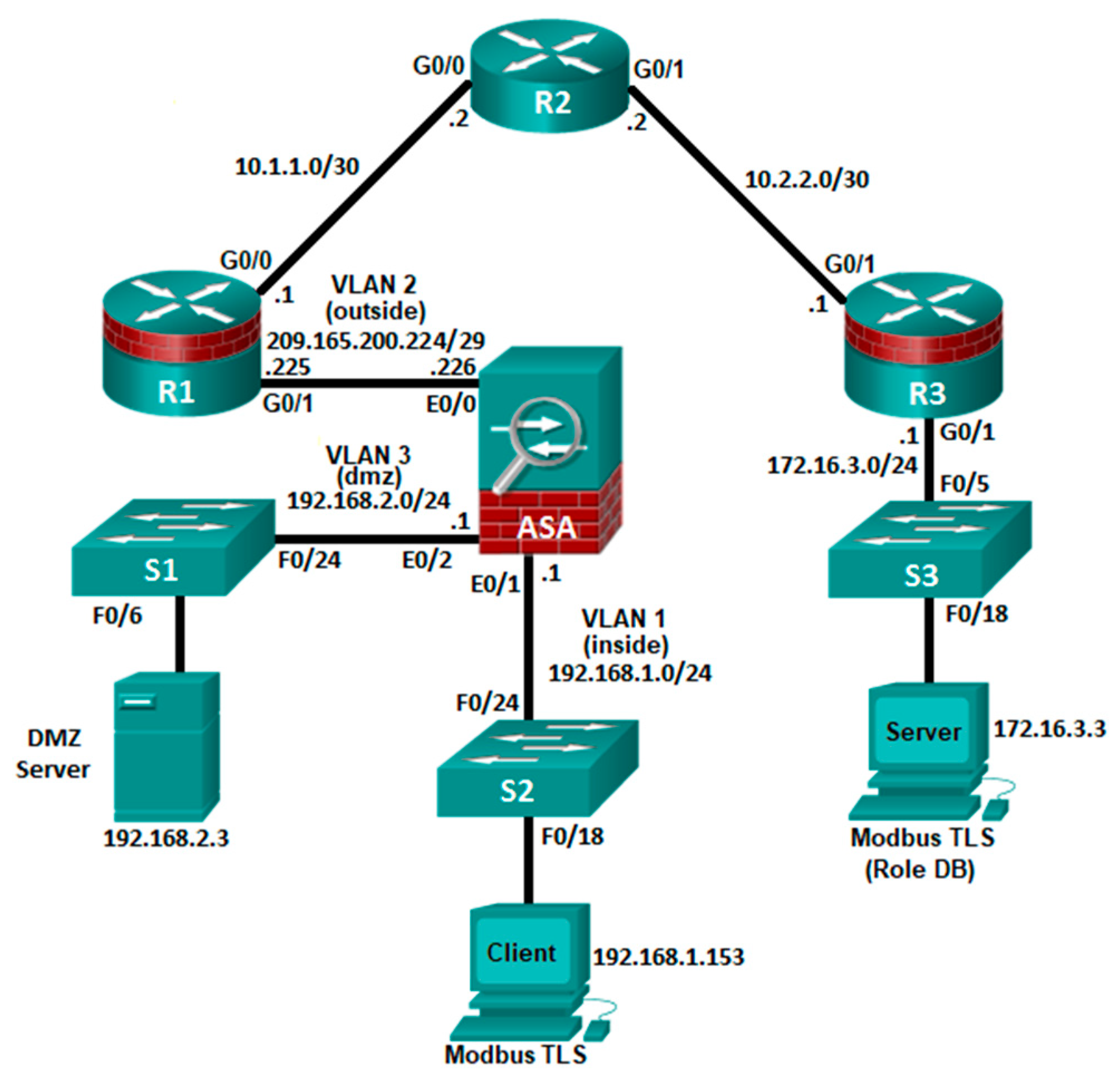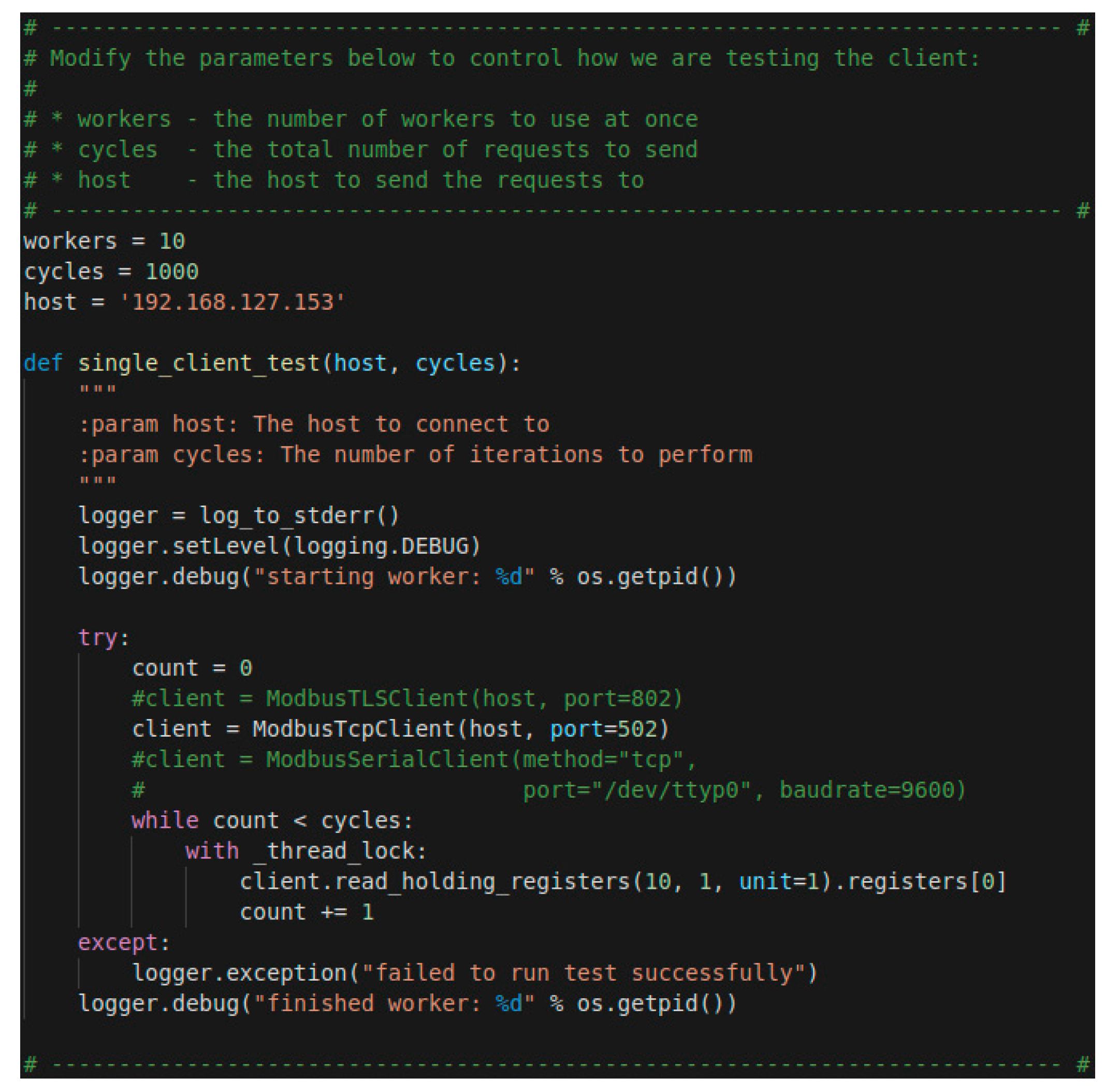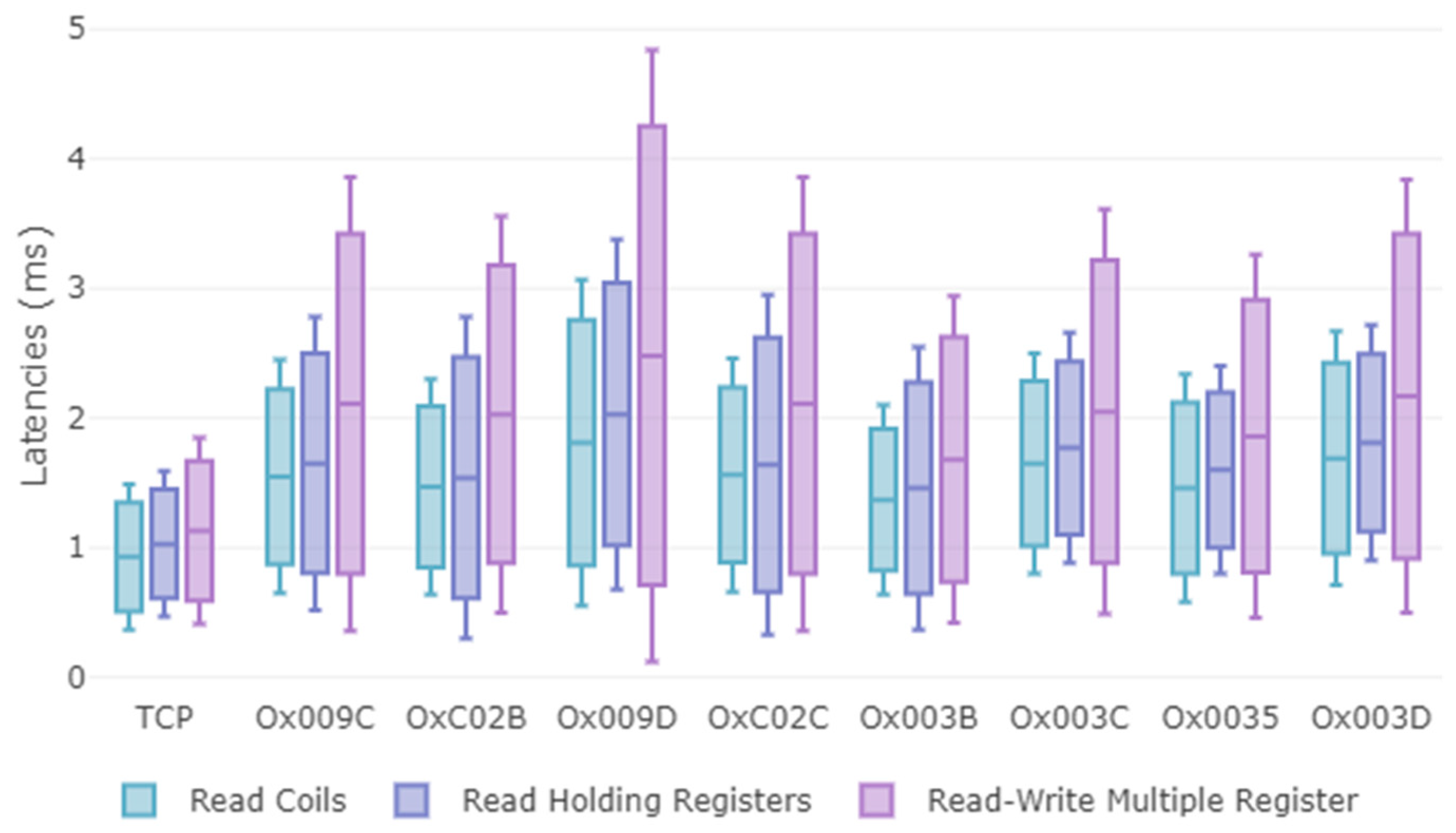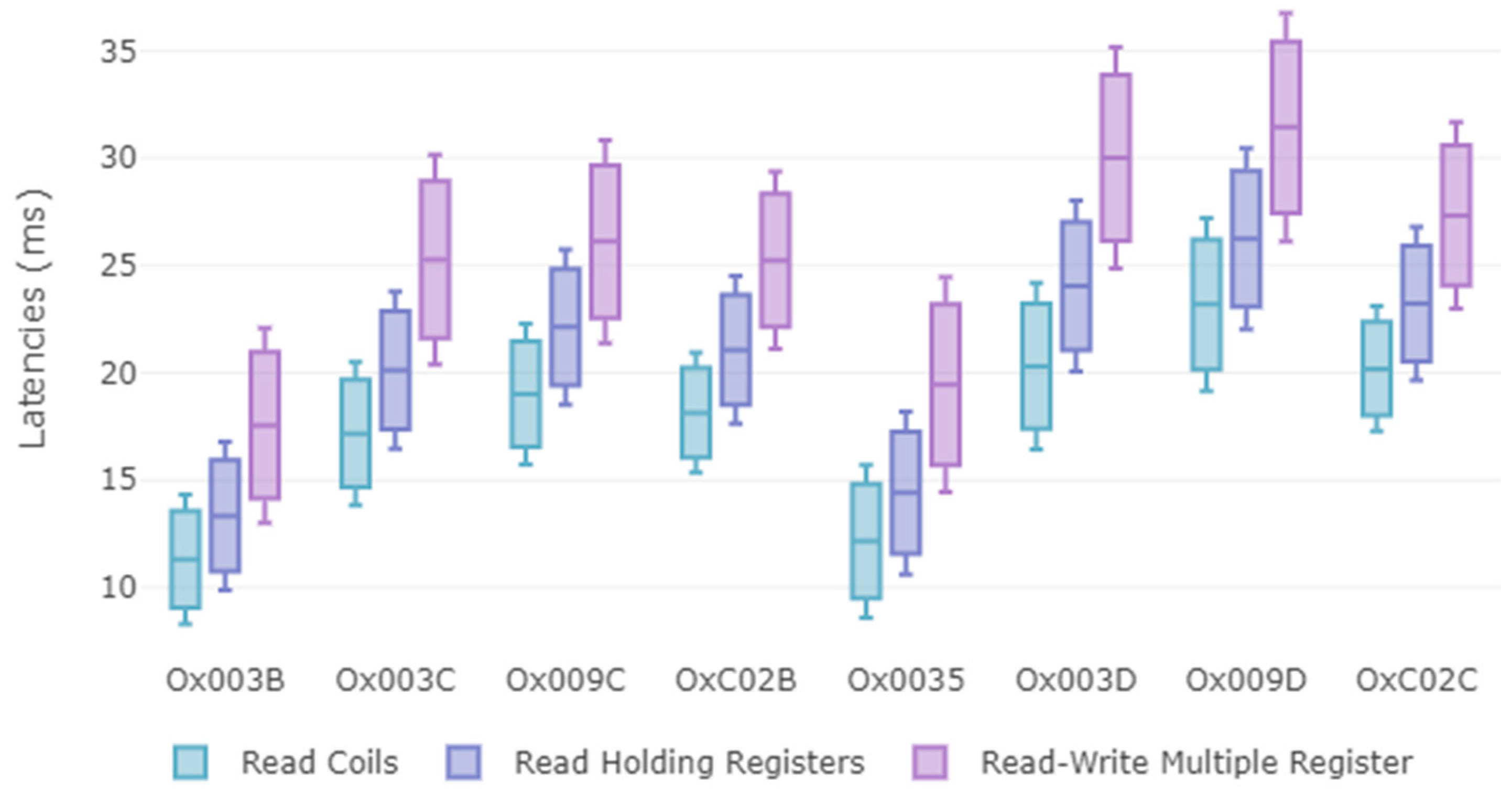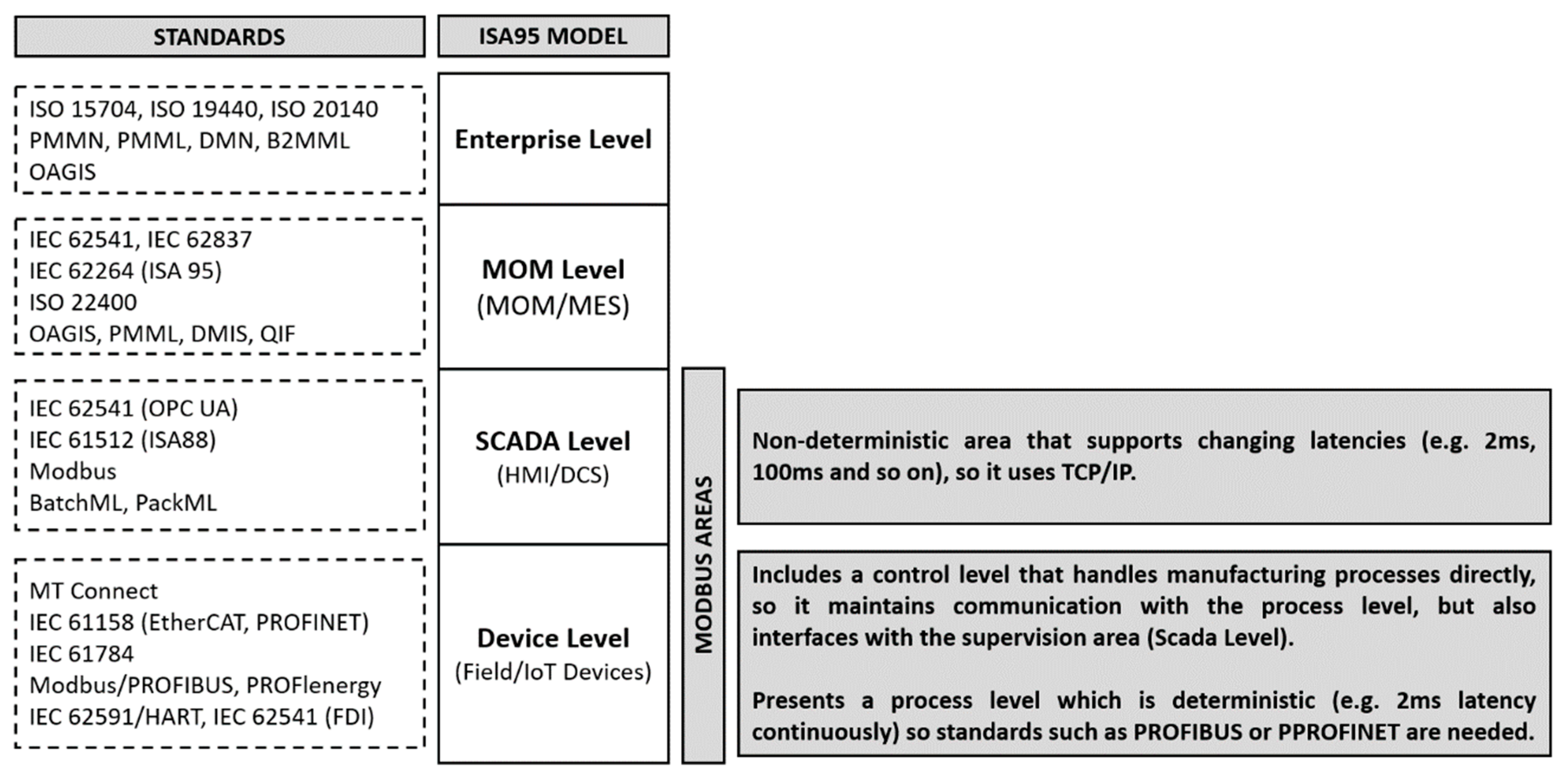1. Introduction
Modbus is an application layer message exchange protocol, which provides client-server communication between devices connected on different sorts of buses or networks [
1]. Modbus has been known as industry’s serial de facto standard since 1979 and keeps on enabling millions of automation devices to communicate [
2]. The Internet community can access Modbus at a reserved system port 502 on the TCP/IP stack. Modbus is a request/reply protocol, and offers services specified by function codes. The Modbus protocol allows an easy communication within all types of network architectures. Every type of device (PLC, HMI, Control Panel, Driver, Motion control, I/O Device, and so on) can use the Modbus protocol to initiate a remote operation [
2].
The
Figure 1 allows identifying action fields of Modbus based on the ISA 95 model and related standards. The Modbus protocol is part of the first two levels of this layered model. However, Modbus TCP/IP is mostly used in the data sharing between the field device level (e.g., PLC, CAN J1939 to the Modbus Gateway) and the SCADA system level. Although Modbus TCP/IP as a protocol could support communication between field devices via TCP, i.e., between sensors, actuators and PLCs, at this point there is an additional requirement: The behavior as a real-time system (RTS). Real-Time support is a requirement mainly for devices at the field level (e.g., sensors and actuators).
In an RTS, if the time constraints are not fulfilled, it can be said that the system has failed. As we have defined, the Modbus protocol TCP/IP implementation is in the application layer, therefore, taking into account the buffering problem, and given that the frames are queued FIFO (First Input First Output), unless a priority setting mechanism is used, as implemented by PROFINET RT, the process is not deterministic, and therefore is prone to introduce delay. In order to contextualize our work,
Figure 2 shows an example of Modbus Network Architecture, where Modbus TCP/IP is not on the field device level, such as Modbus RTU (serial communication over RS-232, RS-485 and RS-422) or Modbus HDLC (MB+). Therefore, Modbus TCP/IP is suitable to enable the communication, for example, between two gateways, an HMI with a PLC, a gateway with a HMI, or an Input/output (I/O) device without RTS requirements.
Therefore, our work focuses on level two in
Figure 1 The high usability of the Modbus protocol at this level, in both Operational Technologies (OT) environments and within industry 4.0 or the Industrial Internet of Things (IIoT), (due to its ability to integrate into industrial processes such as process automation, industrial automation, building automation, power system automation and automatic meter reading), makes the security the main concern of the Modbus protocol. In that sense, we can affirm that the Modbus TCP/IP security problem has its focus on the protocol design. Modbus RTU was scaled to Modbus TCP/IP because the controllers could manage the bandwidth more efficiently, where a client (e.g., a SCADA) could support the connection with multiple servers; however, the Modbus frame TCP/IP was scaled without considering security.
The
Figure 3 helps to understand the statement. As is shown, by default, Modbus PDU includes the Function Code field and Data payload. This function code indicates to the server which kind of action to perform. All function codes are found in the specifications [
2]. When the Modbus TCP/IP frame was defined, only the Slave ID field was changed to an Application Protocol (MBAP) header, and the check error field was removed. MBAP contains only seven bytes [
2]. Therefore, the frame does not include any mechanism to provide authentication or access control. In addition, the default Modbus specification [
2] does not include a mechanism to provide integrity or confidentiality, using, for instance, end-to-end encryption. Therefore, if we adopt the criteria shown in [
5], where it is established that design vulnerabilities are inherent to a protocol specification, present even in perfect implementations, we can confirm that Modbus security problems are related to the protocol design.
However, until a few years ago it was not a problem, since industrial networks (traditional OT) were isolated. Now, it is the age of new factory (the industry 4.0) floor platforms, new technologies such as OPC-UA ([
6] enhances the value of OPC-UA for industry 4.0), new paradigms, such as the Internet of Things (IoT) or IIoT, and the integration between IT and OT environments. Security is no longer a privilege, it is a necessity, and therefore mandatory.
Despite this, several vulnerabilities are found in devices that support the Modbus protocol, which are classified into vulnerabilities by protocol implementation (i.e., exploitation on a specific device because of, e.g., firmware error) or by protocol design (i.e., exploitation on any device using the protocol).
For instance, in the CVE-2017-6819 vulnerability, during the communication between the operator and the PLC through the Modbus 0x5A function, it is possible for an attacker to send specially-crafted packets to consume the PLC resources, and hence freeze it. The product affected was the Modicon M340 PLC. The next reference details the Schneider Electric Report [
7].
In addition, at the Defconf security conference in 2018, a study was presented where an injection attack was made upon three types of PLC (one Modicon, another Allen-Bradley and the third based on an open source PLC, known as OpenPLC [
8]) which supported the Modbus protocol. To perform the injection attack, the same crafted frame was sent to each of the PLC, causing the same result: Denial-of-Service (DoS) [
9].
In order to include security mechanisms to the protocol, in October 2018 the Modbus organization released security specifications [
10], which provide robust protection through the blending of Transport Layer Security (TLS) [
11] with the traditional Modbus protocol. TLS will encapsulate Modbus packets to provide both authentication and message-integrity protection. The security features leverage X.509v3 digital certificates for the authentication of both the server and the client. The protocol also supports the transmission of role-based access control (RBAC) information using an X.509v3 extension to authorize the request of the client.
Although the implementation of the system provides protocol security, authorized voices in the automation world argue that instead of securing Modbus, organizations should invest in technology to deploy a protocol that provides security by design, such as OPC-UA [
12]. However, considering the number of devices supporting Modbus on the network, the option of providing security to the protocol is a solution that many organizations will adopt.
Although the specifications are a guideline to provide security for the Modbus protocol, they have a general approach to implementation, leading to new proposals. For this reason the objective of our work is to improve the security of the Modbus protocol, based on the recommendations [
10], i.e., our proposal is a way to contextualize the specifications [
10] and to demonstrate the viability of it through both a security and a performance analysis. Within the implementation process, we introduce on the one hand the way in which the implementation is carried out, [, the authorization process, and on the other hand, the message authorization of the Modbus frame. Both points are not detailed in the specifications. To this end, this study proposes a role-based access control model (RBAC), which allows the server (e.g., PLC) to authorize a client (e.g., SCADA system) and that once this process has been carried out, and the Modbus frames flow through a secure channel, i.e., they are encrypted, they are also authorized. Since by default, TLS provides authentication of the server and client. Therefore, we are talking about an Authentication and Authorization (AA) model for the Modbus protocol. The authorization process is via a role-based access control. The roles are included as an arbitrary extension in the X.509v3 certificate and validated through a query from the server to a secure database, which has been populated by the client, e.g., the organization that own the SCADA, via an out-of-band (OOB) mechanism such as a secure web form. The authorization process takes place within the handshake phase of establishing a TLS connection, more precisely when the server receives the certificate from the client. Therefore, once this phase is over, any client-server communication will be secure, i.e., encrypted. At this point, the Modbus frame is also authorized, because the Modbus TPC frame contains a unique identifier (unit id) as part of its header, and also since this is transmitted in a secure way. So it can be used to authorize the frame, validated also via a query from the server to the secure database (the same used in the entity authorization process). In order to demonstrate the viability of our proposal, we provide both a security and performance analysis. The security analysis demonstrates the resistance of the proposal to different kinds of attacks. The performance analysis examines the latency behavior, not only for the cipher suites established by the security specifications ([
10]), but also for others that involve a more complex processing and consequently higher latency measures. The remainder of the manuscript consists of related work in order to provide security to Modbus, followed by our implementation proposal. In addition, the corresponding security analysis is carried out. To evaluate our proposal, we will deploy our model on a GNS3 (Graphical Network Simulator-3) network built under the IEC-62443 standard that will allow traffic capture in a controlled environment. This represents our performance analysis. Finally, we provide the results obtained, the conclusions and the future research lines.
2. Related Work
Several efforts have been made to provide security to the Modbus protocol. In order to establish a balance around the analyzed proposals, they are divided between offensive security proposals and defensive security proposals.
On the offensive security side, the first works analyzed was the reference [
13]. It presents a formal model for evaluating the security of the Modbus protocol based on a formal demonstration of the existence of man-in-the-middle (MiTM) attacks in Modbus-based systems. An additional work analyzed is the reference [
14] which adopts a penetration testing approach using a penetration-testing tool based on Intrusion Detection Systems (IDS) to examine the insider threat, as well as the external threat through internal and external penetration testing, respectively. The work presented by the reference [
15] involves an automated tool to generate malicious SCADA Modbus traffic to be used to evaluate such systems. Additionally, the work [
16], demonstrates the attacks to the authentication protocol initially presented by [
17]. A deep analysis of the Modbus protocol specification in order to distinguish the possible attacks was presented by [
18]. The same work ([
18]) identifies several taxonomies, divided into the serial transmission mode and Modbus TCP/IP protocol. All of them consider the existence of a Modbus sniffer or a packet injector.
Other work analyzed was the reference [
19]. It investigates the impact of malware attacks on Modbus-based SCADA networks, such as Code Red, Nimda, Slammer and Scalper. The authors also developed specialized malware to attack Modbus TCP/IP devices. One of them performs DoS attacks to the SCADA system by injecting valid but malicious Modbus packages, consuming bandwidth without alarming a possible IDS system that monitors the network.
On the defensive security side, i.e., mechanisms for detecting and preventing attacks, we have also been able to find numerous works. For instance, the article [
20], proposes a special smart fuzzing technology for Modbus TCP/IP which satisfies the requirement of the vulnerability detection for Modbus TCP/IP. In addition, an abnormal traffic detection mechanism by tracing Modbus TCP/IP transactions is proposed by [
21]. The proposed method ([
21]) enables a response immediate and fast, not only to Denial-of-Service (DoS) attacks, but also to various types of malfunctions, such as routing loops, misconfigured devices and human mistakes. In addition, an authentication model, based upon the one-way property of cryptographic hash functions is proposed by [
17]. Additionally, the article [
22], investigates unauthorized, malicious and suspicious SCADA Modbus activities by leveraging the Darknet address space in order to establish attack prevention models. A solution based on SCTP (Stream Control Transmission Protocol) and HMAC (Hash-based Message Authentication Code) named ModbusSec, is presented by the reference [
23]. The SCTP is a transport layer protocol that provides a reliable message-oriented communication channel, with features such as congestion control and multi-homing. A new secure version based on the TLS protocol which addresses some security problems of the Modbus is proposed by [
24]. The experimental results show that it is feasible to implement TLS by using it as a benchmark of power grid applications. Finally, the work addressed by the reference [
25] is the only precedent of a role-based access control (RBAC) system for Modbus. Additionally, this reference performs a detailed review of the root causes of vulnerabilities in industrial environments. The access control is done on the client side, since they developed a security-hardened architecture for delivering enhanced security for SCADA remote terminal (RTU) devices, i.e., not focused on Modbus TCP. However, it is an interesting proposal, because in addition to presenting the access control approach, they protect the frames cryptographically and check for the existence of a CRC, even though, it does not check for a valid CRC.
From the related work, we can conclude on the one hand that there is evidence of several efforts made, both offensive and defensive security, in order to provide security to the Modbus protocol in the TCP/IP version. In particular, there are two works closely related to our approach, [
24], which proposes an implementation of TLS for Modbus TCP/IP, and [
25], which proposes an RBAC model for Modbus RTU. However, these two schemes, and in general the rest of the efforts, are outside the context of the specification [
10], which is the starting point of our proposal. On the other hand, we can affirm that our proposal presents novelty, because from the recommendations and guidelines provided by the specification [
10], we propose a scheme that includes the following points. First, follows the recommendations of the specification, since it provides the implementation of an RBAC model, over a centralized system, which uses the X.509v3 certificate, for the server to authorize the client, i.e., the role of the client. All of the above procedure is performed within the framework of the TLSv1.3 handshake between the client and the server, which is not a condition established in the specification. Secondly, since the communication channel between the client and the server is protected after the handshake phase ends, i.e., encrypted, we perform the Modbus frame authorization from a unique identifier (unit id) found in the MBAP frame header (
Figure 3). The second point of the proposal is not also addressed in the specification [
10]. In order to demonstrate the viability of our proposal, our analysis includes two stages: Security analysis and performance analysis. The security analysis examines the resistance of the proposal to different kinds of attacks, such as eavesdropping, replay, forgery, and so on. The performance analysis verifies the implementation of the proposal, based on concrete and objective variables, which is measured with respect to changing conditions. These results are compared with established or adopted references. For our proposal, the variable is the latency; the changing conditions are the cypher suites, which, on one hand are defined by the specifications [
10], and on the other hand, we propose to use other cipher suites which are more complex in terms of operations processing, i.e., resource consumption and the benchmarking are latencies and jitter of some industrial services.
3. Proposal of An RBAC Model on A Centralized Architecture
Our proposal consists of a Role-based Access Control (RBAC) model, which is based on a centralized architecture.
Figure 4 shows the general architecture of the proposal. The general architecture of the proposal is formed by five sub-systems: The client, the MBAPS handler, the MBAP handler, the AC module and the Roles Database. It should be noted that the server is composed of three of the five sub-systems: The MBAPS handler, the MBAP handler and the AC module. MBAPS is the acronym for Modbus Application Protocol Secure. Below is a breakdown of how each of these entities interact as part of our proposal. The clients are sub-systems that send the connection request, e.g., a SCADA. Each client must store an X.509v3 certificate. The extension RoleSpecCertIdentifier has been added (
Figure 4) to this certificate. We associate the OID ("1.3.6.1.4.50316.802.1") provided by the Modbus organization on the security specifications [
10]. Additionally, our extension contains three fields. These fields are: roleName (e.g., operator), roleCertIssuer (e.g., client), roleCertSerialNumber (where we will store the Unit ID field). More details about the X.509v3 certificates can be found in the ITU recommendations [
26]. The MBAPS is the entity or sub-system responsible for establishing the secure connection with the client, i.e., it is the entity that receives the client’s secure connection request, authenticates the client via certified, as part of the mutual-authentication process of TLS; hence, it also needs direct communication with the AC module (
Figure 4). Once the secure connection has been established and the frame has been authorized, the MBAPS handler interacts with the MBAP handler to which it sends the Modbus frame. Therefore, this module participates in both the authorization and authentication processes. The AC module is in charge of executing the policies found performing the corresponding verifications in the role database (
Figure 4). The trigger to perform its functions is received from the MBAPS handler module, so in addition to the role database, the AC Module only interacts with this entity (MBAPS Handler).
The role database is a very simple entity whose interaction is based on one side with an out-of-band (OOB) mechanism through which the client populates the database before the connection request, and on the other side, with the AC module, which queries the stored data. This data enables one to perform access control policies (
Figure 4). The MBAP handler module is the entity that communicates directly with the Modbus Memory Area (
Figure 4) and for this, it must receive the Modbus frames from the MBAPS handler. Once the frames have been received, this module separates them according to their function code.
These entities interact as part of the RBAC model, which is composed of two authorization phases. The first uses the role extension of the client’s certificate to authorize it within the TLS handshake stage, and the second authorization phase enables each of the Modbus frames based on the unit_id. Additionally, as part of the TLS handshake, it executes an authentication process of the client and server entities.
Therefore, the next section analyzes both the authorization and authentication phases as part of the handshake. In addition, the
Section 3.2 analyzes the second authorization phase.
3.1. Authentication Phase via TLS and Entity Authorization Phase via Role on X.509v3 Certificate
As
Figure 5 illustrates, the first step in the process is to populate the Role Database. We assume that there is an OOB mechanism (e.g., via a secure web form). The interaction of the role database with the OOB system is shown in
Figure 4. Through this system, the client will be able to insert the Role that they will have in the server, as well as Unit ID that the Modbus frames will have in their header. The client then sends a request to establish a secure connection to the server. Until step 8 in
Figure 5 a normal handshake, this process is performed between a client and a server as part of a TLS implementation. However, this normal handshake includes an important feature of TLS, the first step of the mutual authentication, i.e., the server authentication through the verification of the server certificate (step 5). In step 9, the client adds an extension with the corresponding
role to its certificate, as mentioned in the previous section, before sharing it with the server. All of this as part of the TLS session management.
Once, the MBAPS handler has received the X.509v3 certificate (step 10), it verifies the certified (step 11). This process is the second step of the mutual authentication process, i.e., client authentication (step 11). In addition, the server extracts from it the role; sends it to the AC module, which queries the Roles Database and executes the RBAC policy (step 12 A–step 12 D). This RBAC policy validates that the role stored in the database coincides with the one included in the certificate. Without knowing if their role will be authorized, the client sends relevant information to the server (steps 13–15). These steps are also common within the TLS session generation process. Until the server receives the “Finished” message from the client (step 15), the MBAPS handler will retain the authorization or non-authorization response received from the AC Module. If the role is authorized, the MBAPS handler sends the messages to confirm the cipher specifications and finishes, which steps are also regular in the generation of a TLS session. If the role has not been authorized, the handshake phase ends when the MBAPS handler sends an exception error message to the client and closes the connection.
3.2. Message Authorization Phase
Once the authorization phase between client and server is over, frames can be exchanged securely, using symmetric encryption. These frames will contain the traditional Modbus frames (MBAP + PDU (
Figure 3)). In the
Figure 5, when the MBAPS Handler receives the frame request (MBAP + PDU) (step 18), it extracts the unit_id from the MBAP header and sends it to the AC module (step 19), which queries the Role Database (steps 20–21) and executes the authorization method. The authorization method validates that the unit_id stored in the database matches with the one included in the MBAP header field (step 22). Then the AC module responds by authorizing (or not) the frame (step 23), from which MBAPS handler sends an exception, error message to the client (step 24.B1) or sends the frame to the MBAP handler (step 24.A1) that processes the frame from the function code and interacts with the four areas of the Modbus Memory Area (MMA). The
Figure 4 shows the four areas of the MMA.
4. Implementation Phase
From the sequence diagram of the
Figure 5, in the
Figure 6 we divided into logical actions these design phases in order to simplify the implementation phase. There are three challenges at this point: (1) Select the base library (core library) on which to implement, (2) analyze the mechanism to implement encryption and to enable other security features and (3) analyze the cipher suites to implement.
Our Zenodo reference contains the implementation details that include the Role Database, the arbitrary extension configuration file and the video demonstration [
27].
4.1. Selection of the Core Library
In order to accomplish our implementation we used the open source library, supported by the Community pymodbus [
28]. Although as part of the evaluation phase is shown through performance analysis details of latencies between client and server, without any encryption, i.e., using the unmodified pymodbus library, at this point we can mention that these measurements of latencies was the first criterion used for the selection of the library (see column TCP of both tables of
Section 6.1). The second criterion considered was the language in which it was written: Python; and in third place was analyzed the broad community that has pymodbus, hence, the troubleshooting is simplest.
4.2. Mechanism to Implement the Encription and Other Security Requirements
Once the core library was selected, we proceeded to implement each of the steps shown in
Figure 6, where we show the followed server-side procedure. In order to generate the handshake session a TLS socket was used. Over this socket, the client sends the certificate with the added role extension. Next, the role of the client’s certificate is extracted, the database is queried to recover the associated role to the specific OID, the policy is executed, i.e., it is checked that the role stored in the database, as well as the extracted role from the client certificate, do in fact match, determining the client’s authorization. At this point, the handshake stage and the asymmetric encryption stage are completed.
Therefore, when a Modbus frame is received, the ID unit is extracted from the header, the database is queried again, and the authorization method is executed, i.e., the unit id associated with the OID of the certificate of the client is verified to match with the frame. Finally, the frame authorization is determined, allowing the core library to perform the function code over the Modbus Memory Area (MMA).
Next we detail the three most important points during the implementation stage: (1) The library used to generate the TLS socket, (2) the certificate generation process and (3) the database where the roles are stored.
The implementation of TLS was based on the recommendations provided by Python Software Foundation (PSF) from the wrap_socket handler [
29]. This module provides access to TLS (a.k.a., “Secure Sockets Layer”) encryption and peer authentication facilities for network sockets, both client-side and server-side. This module uses the OpenSSL library. This library supports the use of TLSv1.3, and the management of X.509v3 certificates, where both are essential requirements in our implementation. Another advantage of the library is that it presents the SSLContext.set_ciphers() method, which enables the efficient management of the cipher suites to be selected. The SSL module disables certain weak ciphers by default, but it is possible to restrict the choice of ciphers even further. The following subsection analyzes the used encryption suites.
In order to generate an arbitrary extension, i.e., an extension with a custom OID, a configuration file (openssl.conf) is previously generated, and it is loaded in the command line to generate the certificate. The expression (1) shows the command used to generate the certificate with the added extension. This extension is contained in the openssl.conf configuration file. For more detail, our Zenodo reference contains these implementation details.
Finally, the Role DB database has been implemented using SQLite database. For instance, expression (2) is the simple instruction used to create the Table over our “RoleDB.db” to perform the proof of concept (PoC). It is composed of a table with the attributes: Role, oid, and unit_id, which are gotten from the same client, and are used to authorize the client and to authorize the Modbus frame, respectively.
4.3. Cipher Suites to Implement
The specifications [
10] set the lowest boundary of the cipher suites to be used, in terms of resource consumption due to processing, while maintaining minimum security levels. However, as cipher suites will be used as a resource in our evaluation phase for performance analysis, we have decided to perform an analysis of other cipher suites and to establish a comparative analysis with respect to those defined by the specification [
10]. The cipher suite represents which cryptographic algorithms and methods should be used, and it is defined by [
30]. Currently, there are 339 suites officially supported, that target different applications and security levels. The cipher suite name contains the key exchange, the authentication method, the key exchange algorithm and the symmetric algorithm for an authenticated encryption of application data transfer between entities.
For instance, TLS_ECDH_ECDSA_WITH_AES_128_CBC_SHA (0xC004) states that the Elliptic-curve Diffie-Hellman (ECDH) will be used as key exchange, while Elliptic Curve Digital Signature Algorithm (ECDSA) will be used as digital signature, and AES_CBC_SHA will be used to construct the symmetric authenticated encryption (Advanced Encryption Standard (AES, a.k.a. Rijndael) with Cipher Block Chaining (CBC) mode for encryption and HMAC with SHA for the construction of the Message Authentication Code).
Table 1 sets the encryption suites recommended by the specifications [
10] and
Table 2 sets the cipher suites that are additionally sampled.
As it can be noticed when comparing both tables, the cipher suites proposed in
Table 2 are more complex than those proposed in
Table 1, i.e., in terms of the computational cost required to implement each. However, in order to select the suites that we have proposed in
Table 2, we have examined the corresponding relationship with those presented in
Table 1, with the objective of stressing the system and obtaining measures of higher latencies. For instance, if we compare 0xC02B with 0xC02C, a similar structure is visible in terms of the key exchange, the authentication method and the symmetric algorithm construction for encryption, however, on the one hand, 0xC02B uses AES_128_GCM while 0xC02C uses AES_256_GCM, and on the other hand, 0xC02B uses SHA256 while 0xC02C uses SHA384.
7. Conclusions
Applications that use SCADA systems rely upon protocols such as Modbus to enable their operations. Many protocols widely deployed lack basic security mechanisms, such as confidentially and the authenticity of transmitted data. When deployed in critical infrastructure assets, these applications enable advanced control possibilities. The exposition of those systems by incorrect deployment or existing vulnerabilities, both in design and implementation, create new attack scenarios. Based on the security recommendations established by the Modbus organization, our manuscript includes a role-based access control model (RBAC) as an access control mechanism, in order to authorize and authenticate systems based on Modbus. This model is divided into an authorization process and an authentication process. The authentication process is provided by TLS, because by default this implements mutual authentication. The authorization process includes both the entity authorization as well as the message authorization. The entity authorization is via roles, which are included as an arbitrary extension in the X.509v3 certificate. The roles are validated with a value stored in a secure database, populated from an out-of-band mechanism. The message authorization process is via a unit id, where it comes from a unique identifier containing the frames, which is validated from a query to the secure database (same database used by the authorization process). In order to evaluate our implementation that we have based on a security analysis, which indicates the attacks against which our implementation is resistant, also justifying the correct implementation. In addition to the security analysis, we perform a performance analysis, since the cipher suites support the mechanism mentioned above different cipher suites were analyzed, establishing a comparison with benchmarks, arriving at the conclusion of the feasibility of the model presented.
Since one of our lines of research is access control, based on attributes (ABAC) in decentralized systems ([
40,
41]) and this model of access control based on roles (RBAC) has been applied in a centralized environment (Role Database), the first future line of research is to apply this model in a decentralized environment based on blockchain. Additionally, we want to provide results to systems based on both Hyperledger Fabric Blockchain and Ethereum blockchain. Thirdly, the creation of a robust mutual authentication RFID protocol that works together with our ABAC blockchain system in order to build a secure supply chain system.
